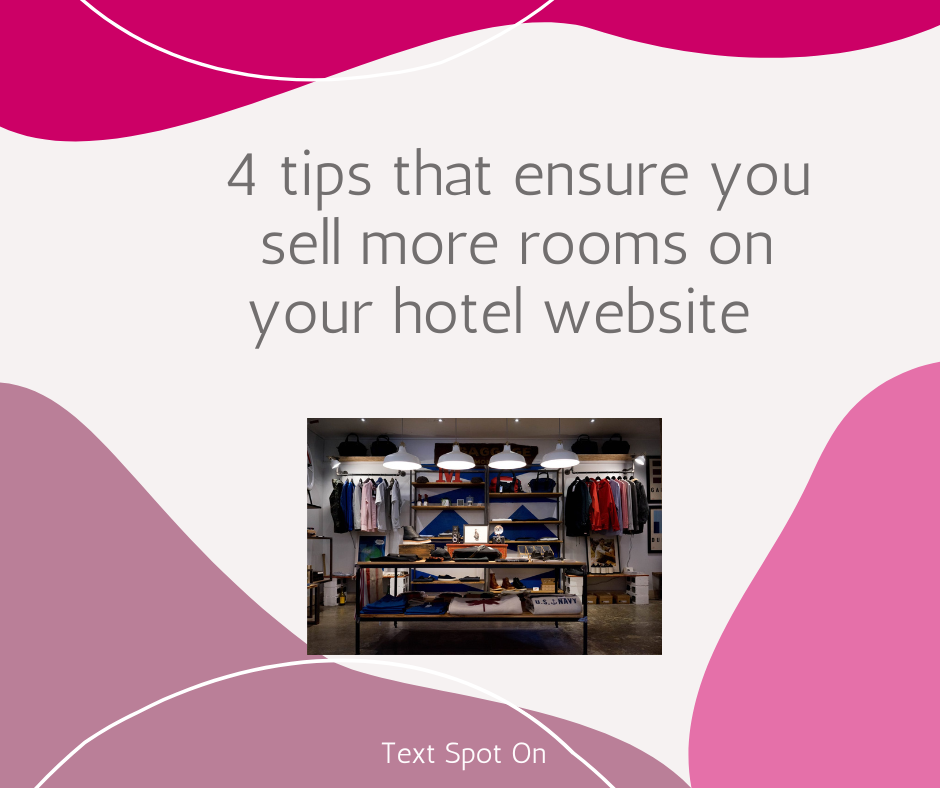Do you want to sell more hotel rooms on your website?
4 tips to make it work.
Guests should book their room directly with you, no question. But selling hotel rooms is like any other product – the better you package and present your product, the better the business will be ..
photo: courtesy unsplash-clark-street-mercantile-33931
When was the last time you went to your favorite store?
Ahhhh, and why do you like it there so much? Most likely because you enjoy shopping there. Clean and attractive, a nice atmosphere, and shopping is easy and hassle-free. The shopping experience is right.
Now go to a hotel website to reserve a room. You’ll see a nice photo, a list of furnishing and design features, and that’s it.
Great that you now have all the information, from the square footage of your room to the adjustable shower head, but does that really convince you to make a reservation?
Shouldn’t hotels also offer a shopping experience that guests enjoy? ….and thereby sell more hotel rooms?
Making your online hotel store attractive and welcoming is actually relatively easy if you keep four key points in mind:
1. Your guest wants to be motivated to book.
Give them a good reason.
Do you buy shoes because of their patented footbed or great insole? No, you buy shoes because they are comfortable, look good and are great to walk in.
The same applies to hotel rooms. Your guests are not looking for real estate or interior design, they are looking for a great Hotel experience.
Don’t get me wrong. If you have lovely rooms, you naturally want to show them off and rightly so.
But if you meet guests in your hotel lobby and they ask you which room you could recommend, would you discuss details like mattress size and carpet texture with them? Probably not…
You’d very likely ask them a few questions: What they have in mind, what needs and preferences they have and, depending on their answer, you’d make your recommendation.
Selling hotel rooms has everything to do with your guests’ needs. Not the product details, but the convenience of your visitors should be in the foreground.
2. Stand out from the competition with a successful shopping experience:
What you say and how you say it makes all the difference. Here are some fine examples of hotels that attract and connect with website visitors:
“In your 35m² room, you have so much space that you can dance in the comfort of your own home”.
One sentence and the “Madison Hamburg” not only informs, but at the same time triggers a positive feeling while reading… You can already see the exhilarating stay at the Madison in front of you…
Or take the Dylan Amsterdam. It not only introduces its managers on the website, but also lets them speak to the visitor in a very authentic and personal way. Very personable and trustworthy. You feel like you know the team members personally and that’s important because… we prefer to buy from people we like…
3. A SMALL selection sells MORE.
Image courtesy Aleks Marinkovic/Unsplash
Visit a number of hotel websites and you will find up to 15 different room types and 4 different seasons. In the fine print, taxes will be added to this, special discounts applied, that is if (…insert relevant condition here….), conditions, clauses and policies – information scattered all over the place and making it unnecessarily difficult to book. You start and then…. you just want to leave.
Sure, revenue management allows you to optimize your inventory and maximize your revenue.
But it’s not working once it gets too confusing and complicated for potential guests…
They won’t waste their time or energy trying to make sense of what you have to offer.
Too much supply can even negatively impact sales. In his book “The Paradox of Choice”, published in 2004, the American psychologist Barry Schwartz shows what happens when we have too many choices.
Imagine you need a new printer. You go online, visit Amazon, click “Inkjet Printer” and you see 1,894 results. Perfect – lots of choice and all you have to do is decide. But how many printers do you have to look at to find the right one, and how do you know your choice is really the best one? Doubts are coming up, causing you to hesitate and making it harder and harder to decide…
It’s similar in the supermarket. Have you ever stood in front of a selection of 24 delicious jams and tried to make a decision? Sheena Iyengar, author of “The Art of Choice,” asked her panel to do just that. At her experiment the aim was to determine how selection influences purchasing decisions.
And the result was clear: with a selection of 24 jams, only 3% of the test group bought. In the comparison group, which only had a choice of 6 jams, a subsequent sale of 30% (!) was recorded.
A great hotel shopping experience is one that is welcoming, relaxed, and seamless. Ideally, there is a “best room” and a selection below and above this price category. Availability and costs are presented in a clear and uncomplicated manner.
Guests are not forced to think for a long time, but can find all the information they need with two or three clicks. Believe me, the more complex it gets, the quicker your guest will abandon the booking process, and once they’re gone, you’ll most likely lose that direct booking forever…
4. Make reservations easy, convenient and intuitive for your guests.
Whatever reservation system you use, it needs to be tailored to your guests. The user-friendliness of your system makes all the difference. Because no matter how much valuable information the system provides you in the background or how easy it makes YOUR life – if your guest finds it too tedious, he will cancel the reservation process and you have probably lost it …
Here are some nice examples of how to do it right:
The Kimpton Chicago makes selling hotel rooms a true pleasure. Booking is an uncomplicated process and it is even fun! They have perfected the art of upselling, by tempting you with great images and sweet words that make it fun to add to your celebration. “How about a dozen chocolate-dipped strawberries?”
The booking page layout has style, is easy to use, entertaining and just feels perfect.
Here’s a completely different approach:
Motel One, London Towerhill, shows all information at a glance and makes it super easy for their guests. All the important details – very skilfully staged – can be seen on the homepage. From price to guest reviews, from departure time to contact information – everything is there at a glance. No searching, no further clicks needed – all information is at hand and helps guests make quick decisions.
Or take a look at the Virgin Hotel Chicago. They have turned their hotel rewards into something truly special. Signing up for a loyalty program with Virgin is worth the effort.
“Get in the Know” is the name of the program. Members can decide for themselves which gestures and gifts will make them happy. The hotel asks their guests to fill out a questionnaire. And while guests have fun answering the fun and witty questions, the Virgin Hotel Chicago collects tons of valuble information about the interests and preferences of their guests…
With the answers, the hotel now knows “everything” about you – from your favorite minibar content to your favorite artist. Important information that will help the hotel pamper you personally during your stay.
It doesn’t take much to make your online shop more attractive, but don’t wait too long, or you’ll lose valuable direct bookings!


